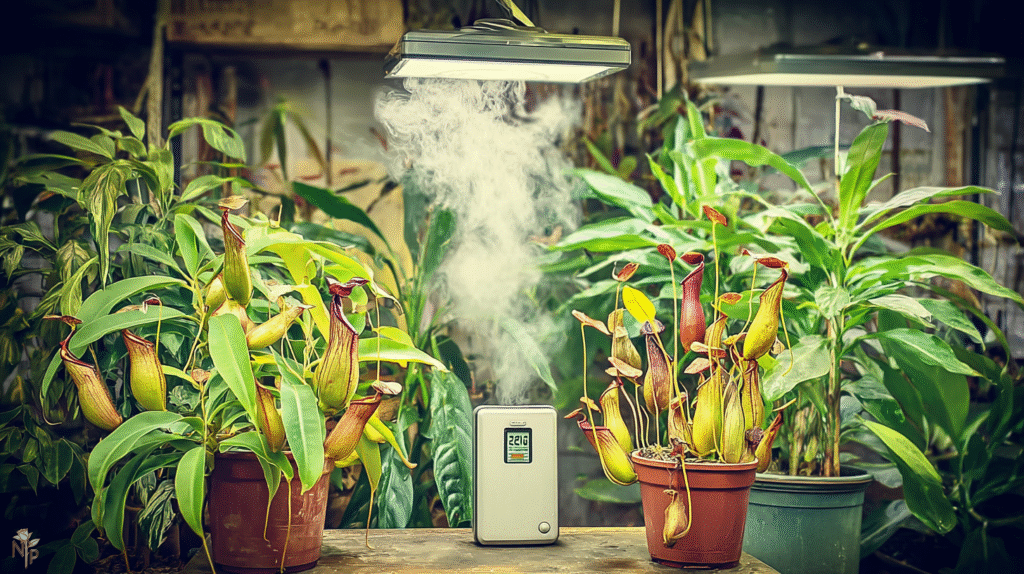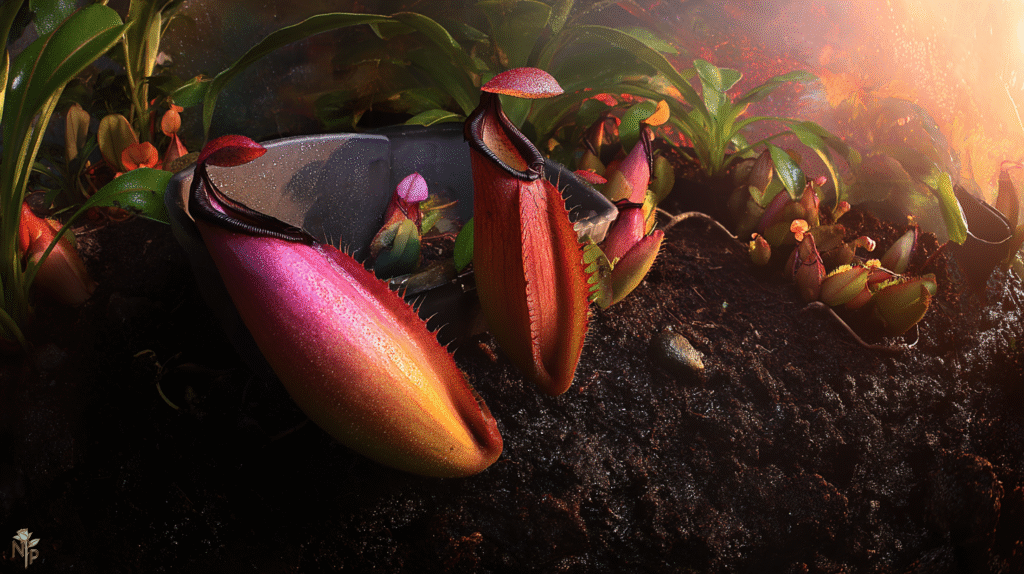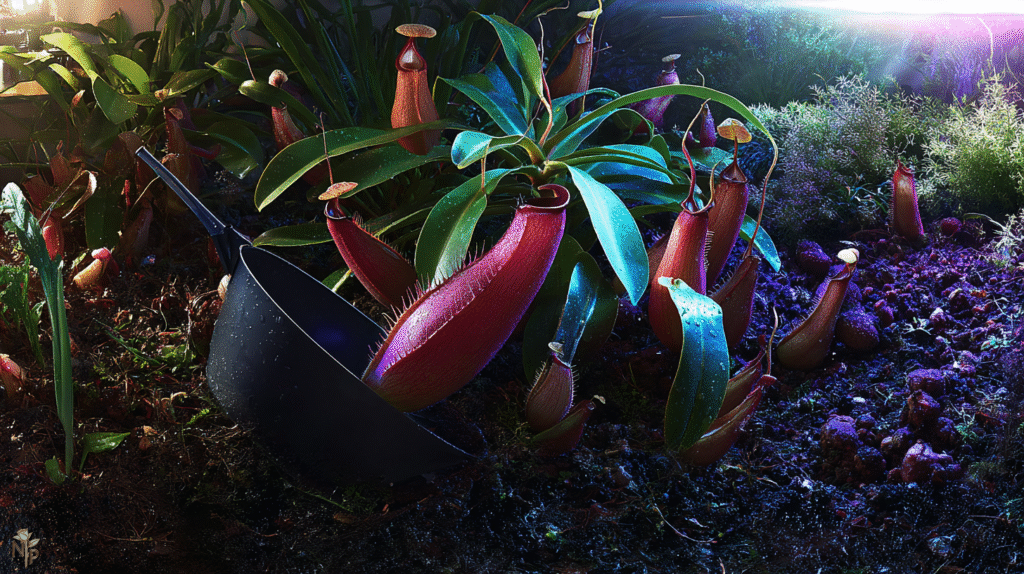My first tropical pitcher plant cost $45 and lasted exactly 17 days. I’d fallen hard for those dangling pitcher traps at the specialty plant shop — they looked like nature’s version of medieval torture devices, but prettier. The shop owner assured me they were “easy with the right setup.”
What she failed to mention was that “right setup” meant recreating a Southeast Asian cloud forest in my living room.
Two years and roughly $400 in dead Nepenthes later (yes, I kept trying because I’m stubborn), I finally have three thriving pitcher plants producing traps bigger than my fist. Turns out, these aren’t houseplants trying to be carnivorous — they’re carnivorous plants barely tolerating being houseplants. Once I understood their actual needs versus what I thought they needed, everything changed.
Why Tropical Pitcher Plants Are Nothing Like Venus Flytraps
Let’s clear this up immediately because I made this mistake: Nepenthes (tropical pitcher plants) and Venus flytraps are as different as orchids and cacti. Just because they both eat bugs doesn’t mean they want the same things.
Venus flytraps: Want full sun, winter dormancy, sitting in water trays Nepenthes: Want bright shade, constant warmth, never sitting in water
I killed my first Nepenthes treating it like my successfully growing flytraps. Turns out, that’s like giving a rainforest plant desert treatment. No wonder it gave up.
The Humidity Requirement That Changes Everything
This is the make-or-break factor. Nepenthes need 60-80% humidity consistently. Not occasionally. Not “I misted it this morning.” Constantly.
My humidity journey:
- Started with misting: Pitchers dried up in days
- Tried pebble trays: Raised humidity maybe 5%
- Bathroom placement: Still not enough
- Finally built a grow tent: Game changer
That grow tent was my turning point. Yes, I have a 2x2x4 foot tent in my living room. Yes, visitors ask questions. But my Nepenthes are finally producing pitchers instead of just leaves, so I’ve made peace with looking like a plant weirdo.
Inside the tent:
- Small humidifier on timer
- Humidity meter (essential)
- Stays between 70-75%
- Ventilation fan prevents stagnation
Without this setup, I was just slowly murdering expensive plants.
Temperature: The Highland vs. Lowland Drama
Nobody at the plant shop mentioned this crucial detail: there are two main types of Nepenthes with completely opposite temperature needs.
Highland species:
- Day: 70-80°F
- Night: 50-60°F
- Need 15-20° temperature drop
- From mountain elevations
Lowland species:
- Day: 80-90°F
- Night: 70-75°F
- Minimal temperature drop
- From sea level areas
Guess which type I bought first? Highland N. ventricosa. Guess what temperature my apartment stays? Constant 72°F. That poor plant never stood a chance.
Now I stick to lowland and intermediate hybrids that don’t demand mountain weather. Unless you can provide serious temperature drops, avoid pure highland species. Trust me on this.
Light: Bright But Not What You Think
The tag said “bright indirect light.” What it meant was “rainforest canopy filtered light,” not “back of the room kind of bright.”
What doesn’t work:
- Dark corners (no pitcher development)
- North windows (too dim)
- Direct sun (burned leaves, stressed plants)
What actually works:
- LED grow lights 12-14 hours daily
- East windows with sheer curtains
- Bright shade outdoors in summer
- 10,000-15,000 lux for best growth
My tent has a full-spectrum LED panel. The difference between grow lights and window light? Night and day. Pitchers develop faster, bigger, and more colorfully under proper lighting.
Water: The Goldilocks Situation
Nepenthes are picky about water in ways that surprised me.
Water quality matters:
- Distilled or reverse osmosis only
- Tap water minerals = death
- Rain water works if clean
- TDS under 50ppm ideal
I killed a beautiful N. sanguinea with tap water. The minerals built up, roots burned, game over. Now I buy distilled by the gallon. It’s annoying but cheaper than replacing plants.
Watering technique:
- Keep media moist, never soggy
- Never let it dry completely
- No water trays (not bog plants!)
- Water when surface starts drying
Think “wrung-out sponge” moisture level. Too wet = root rot. Too dry = stressed plant dropping pitchers.

Media: Not Your Average Potting Mix
Regular potting soil kills Nepenthes faster than neglect. They need airy, moisture-retentive media that doesn’t decompose quickly.
My mix that works:
- 50% long-fiber sphagnum moss
- 30% perlite or pumice
- 20% orchid bark
- Optional: horticultural charcoal
Some growers use pure sphagnum. I find the mix provides better aeration and lasts longer. Repot every 1-2 years as media breaks down.
Pot selection:
- Plastic retains moisture better
- Net pots increase air flow
- Size up gradually
- Drainage holes essential
Feeding: Easier Than Expected
Here’s the good news: feeding is the easiest part of Nepenthes care.
Natural feeding: If outdoors in summer, they catch plenty. Indoors, occasional flies find their way in. The plant can photosynthesize — bugs are just fertilizer.
Supplemental feeding options:
- Diluted MaxSea fertilizer in pitchers monthly
- Freeze-dried bloodworms (pet store)
- Recently dead insects
- Coffee grounds in pitchers (controversial but works)
What I do: 1/4 teaspoon MaxSea per gallon, few drops in each pitcher monthly. Plants grow noticeably faster with feeding but survive fine without.
Never:
- Overfeed (pitchers die faster)
- Use meat or cheese (they rot)
- Force-feed closed pitchers
- Fertilize roots directly
Common Problems I’ve Faced
No pitcher development: Always environmental. Check humidity first, then light. My N. alata produced only leaves for six months until I fixed humidity. First pitcher appeared within three weeks of proper conditions.
Pitchers drying/dying quickly:
- Humidity too low (most common)
- Natural aging (they last 1-3 months)
- Overfeeding
- Stress from changes
Leaves yellowing:
- Usually overwatering
- Sometimes nutrient deficiency
- Check roots for rot
- Adjust watering first
Black spots/rot:
- Fungal from poor air circulation
- Too cold and wet
- Increase ventilation
- Remove affected parts
The Investment Reality
Let’s talk money because Nepenthes aren’t cheap:
Initial costs:
- Plant: $20-100+ depending on species
- Grow tent: $80
- Humidifier: $30
- LED light: $50-100
- Humidity meter: $10
- Distilled water: $1/gallon ongoing
That’s before you get addicted and want more species. But compared to killing expensive plants repeatedly, the setup pays for itself.

Species for Beginners
After expensive failures, these are reliably easier:
N. x ventrata:
- Most forgiving hybrid
- Tolerates lower humidity
- Produces pitchers readily
- Usually under $30
N. sanguinea:
- Beautiful red pitchers
- Handles average conditions better
- Good second plant
N. maxima:
- Vigorous grower
- Large impressive pitchers
- Tolerates mistakes
Skip highland species, rare cultivars, and anything over $50 until you nail basic care.
Why I Keep Growing These Demanding Plants
They’re not easy. They require equipment, specific conditions, and constant attention to humidity. My electric bill went up. I have a grow tent as living room furniture. I buy distilled water weekly.
But when a new pitcher opens, when the light hits that peristome just right, when visitors literally gasp seeing them — worth every penny and effort. These aren’t just plants; they’re living sculptures that evolved an insane solution to nutrient-poor soils.
Plus, they control every fungus gnat in my apartment. Practical art.
The Bottom Line on Tropical Pitcher Plants
Nepenthes aren’t casual houseplants. They’re commitment. If you want something easy, buy a pothos. But if you’re fascinated by carnivorous plants and willing to provide:
- Consistent high humidity
- Proper temperatures
- Bright filtered light
- Pure water
- Appropriate media
You’ll be rewarded with one of nature’s most incredible creations.
My journey from serial Nepenthes killer to successful grower took patience, money, and dead plants. But now I can’t imagine not having these weird, wonderful pitcher plants in my life. Just be honest about the commitment before starting. These aren’t plants you can neglect and apologize to later — they’ll be dead before you get the chance. 🪴







